Thanks to the improvement of the technical process, it was possible to achieve a significant increase in productivity, which will amount to more than 15% according to the SysMark test. So this year's performance Core processors i7 will grow more than in the past. This is shown in the slide from the presentation at the top, titled "Moore's Law Advance at 14 nm".
A new generation of processors based on an improved 14 nm platform is scheduled for release in the second half of 2017. These will be designated as the Core i7/i5/i3-8000 family and will replace the existing 7th generation family.
At the presentation for investors, Intel did not say anything about plans to release the Cannonlake (formerly Skymont) family of 10-nm microprocessors. technological process. They are supposed to come out at the end of 2017, and a working sample of Cannonlake at 10nm was shown recently at CES. It was the Cannonlake family that was previously positioned as the 8th generation of processor architecture, which will replace Skylake as part of the tick-tock strategy. Now another family has appeared that has nothing to do with Cannonlake. Perhaps this is an attempt to sell an old product in a new package.
Cancellation of the tick-tock strategy
Intel has consistently followed a tick-tock strategy since 2006. Since then, every two years it has released processors using a new process technology, significantly increasing the number of transistors on a chip. Each transition to a new process technology was designated as a "tick", and the subsequent improvement of the microarchitecture with the same process technology was designated as a "tick". The giant of the semiconductor industry has worked like a clock for ten years, issuing new architectures without failure.It seems that in 2016, Intel's "clock" shorted a little to 14 nm, and the company announced about.
In principle, there is nothing wrong with this. To reiterate, this year's chip performance growth (over 15%) will be even greater than last year's (15%), Intel said. Maybe it's really better to squeeze the entire reserve out of the existing technical process, optimizing it, and only then move on. We cannot criticize Intel for departing from a strategy it has voluntarily set for itself.
One way or another, but now the tick-tock strategy has been modified into a different form.

Instead of a measured metronome, a new procedure has now been implemented with a greater emphasis on optimization. Perhaps a new architecture will not be released every two years, as it used to be.
Why isn't Intel pushing the transition to 10nm? It doesn't need to do this because it believes it is already far ahead of competitors in the semiconductor industry (Samsung, TSMC, and others) in its technological superiority. The company estimates this gap at about three years.
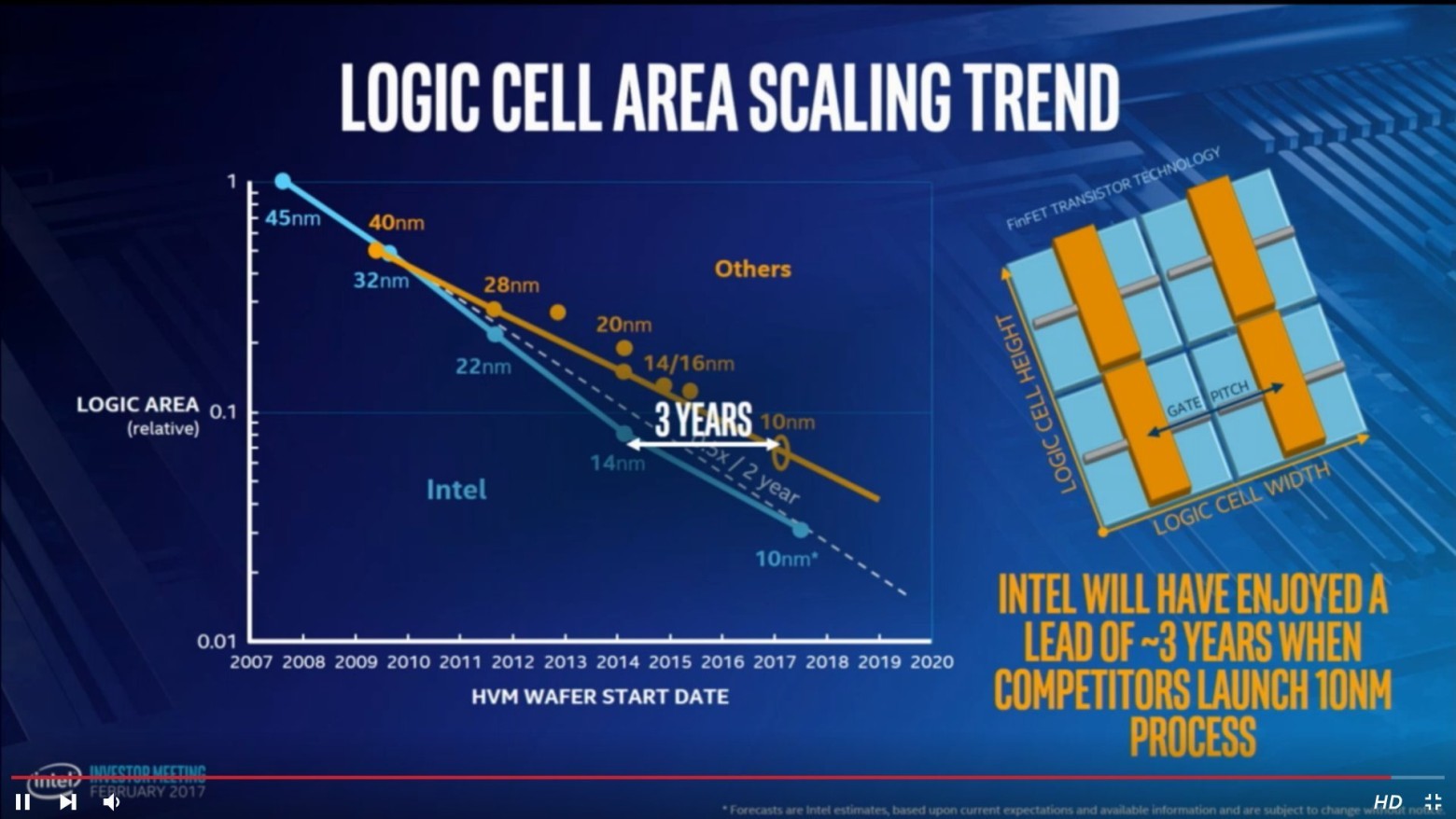
Such a reserve allows you to feel quite confident.
New factory for 7nm
The bright future of Moore's law should be provided by the new Intel Fab 42 plant, which will be able to provide production on the 7 nm process technology.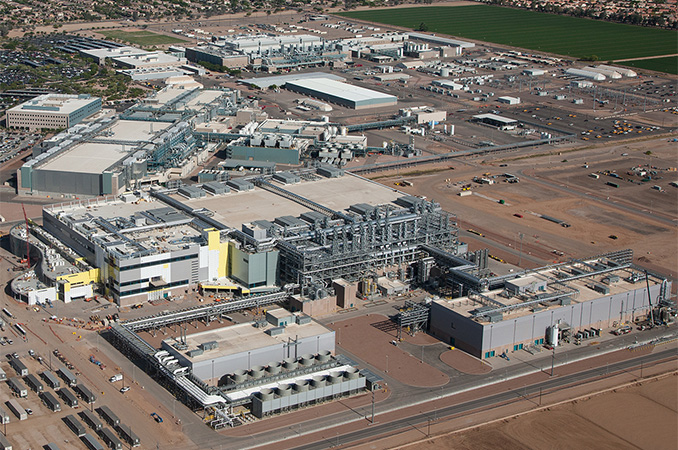
Construction and equipment will take another three to four years and will require significant investment. The plant in Chandler, Arizona will reduce the number of local unemployed by about 3,000 people (+ another 10,000 jobs added indirectly).
Construction on the Chandler plant began in 2011. It should become the most advanced and innovative semiconductor enterprise in the world. The building itself was completed in 2013, but instead of installing 14 nm equipment in early 2014, Intel decided to delay the launch of the pipeline. IN this moment the plant is ready: air conditioning, heating and other systems - everything is functioning, it remains only to install and adjust the equipment. Intel has no plans to use this factory for 10nm production, so in a few years, it is quite likely that they will master production at the next 7nm process.
Intel estimates that the hardware will cost about $7 billion. That's the cost of a modern industrial plant. It is not yet known what specific equipment will be needed. Perhaps Intel will start using photolithography in deep ultraviolet (EUV) there.
At the dawn of the 2000s, Intel hoped that by 2005 processor frequencies would rise to 10 GHz, and they would operate at voltages below a volt. As we know, this did not happen. About a decade ago, Dennard's scaling law stopped working, stating that by reducing the size of transistors, you can reduce the voltage applied to the gate and increase the switching speed. Since then, it is rare for a processor to receive a nominal operating frequency above 4 GHz, but there are more cores, per chip with motherboard the north bridge migrated, other optimizations and accelerations appeared. Now Moore's law, an empirical observation that speaks of a constant increase in the number of transistors on a chip due to a decrease in their size, is also slowing down.
High performance and reliability of processors by Intel have long been known throughout the world. The processors of this company are very popular among both IT professionals and ordinary users. On the Russian market, Intel presents the widest range of modern processors. Reliable low-cost processors are still in use and in demand Intel Pentium and Intel Celeron, which have long been known to Russian consumers and are intended for use in basic computers. But processors of the family Intel Core second generation. They attract attention, first of all, with the possibility of automatic increase in productivity. Intel Turbo Boost Technology 2.0 allows you to automatically increase the processor clock speed for more complex tasks. Intel Hyper-Threading Technology allows Intel Core processors to multitask between four and twelve tasks simultaneously (performance may vary by various models processors). The consumer receives data processing acceleration several times compared to previous generation processors. Another notable advantage of the second generation Intel Core processors is the presence of built-in image processing, which allows you to achieve exceptional brightness and clarity of the picture on the monitor - a huge plus for all professional and home users working with images, watching movies and TV broadcasts. Another new Intel - quad-core, six-core and eight-core processors Intel Xeon. The combination of innovative technologies using special materials from rare earth metals has created a line computer processors with high performance and dynamic scalability. For an ordinary consumer, this, in fact, means fast and continuous operation of the processor to solve many problems simultaneously, the correct operation of the most complex modern software applications, high quality display of video and audio content and a significant reduction in power consumption. Another recent development from Intel that should not be overlooked is the processor Intel Atom, which is intended to become the basis for a variety of modern Internet devices that support 3G or 4G networks. This processor provides the high performance required for stable and fast mobile connections to the Internet, as well as high-quality processing of high-definition video and audio signals. Thus, almost every consumer can buy one or another Intel processor model that best suits his expectations and preferences. Intel processors of the latest generation are quite capable of effectively and reliably solving the entire range of computer tasks.
It can be difficult for a beginner, or a person who has not followed the progress in the computer components market for a long time, to understand the list of alphanumeric processor indices in the price list of a store. For example, in decoding the designation "Intel i5-3570K".
Being guided by the applied designations, it is possible to determine the characteristics of the processor without reading its technical specification. Understanding this, you definitely do not need laptop repair. Below we will consider the main designations used in the marking of Intel desktop processors.
Intel processor family
The name of the new generation begins with the definition of the family.
i3 is a family of dual-core processors. Perfect for a working machine in the office, older models can be installed in an inexpensive gaming station.
i5 - quad-core processors. Intel's hottest product line. They provide a full range of computing power levels, from relatively inexpensive models to powerful gaming or work systems.
i7 - more powerful, and therefore more expensive models. Includes quad- and six-core processors. In case of application in home computer the performance gain over the i5 does not justify the investment. Mainly used in servers entry level and workstations for resource-intensive applications (such as video encoding).
Intel processor generation
2 - processors on the core of Sandy Bridge. The last generation of crystals. They have great overclocking potential. In the overclocked state, they are comparable to the processors of the latest generations. At regular frequencies, slightly, by 10 - 15 percent, they are inferior to them. Gradually goes out of circulation.
3 - processors on Ivy Bridge. previous generation. The overclocking potential is lower, but the level of specific performance is significantly higher. In terms of price / performance ratio, perhaps the most profitable choice.
4 – latest generation processors on the Haswell core. The overclocking potential is even lower than that of Ivy Bridge, therefore, in the overclocked state, the performance is approximately equal to the previous generation, only the cost is slightly higher.
Intel Processor Model
The next three digits are the processor model.
It makes no sense to list the values of all models, there are a lot of them. The only thing worth knowing is that the higher the value, the more powerful processor. The first of the three digits indicates the level of the model, the rest - the detail. For example, i5-3570 will be somewhat faster than i5-3450.
The letter index that completes the designation can indicate both the enhanced capabilities of the crystal (for example, the letter K indicates an unlocked multiplier for overclocking), or vice versa, reduced characteristics (the T index, lower clock frequencies to reduce heat generation). Simplifying the classification, we can say that it is best to take a processor either without a letter index at all (i5-4670), or with a K index for overclocking (i5-4670K).
Intel will soon begin shipping a new family of processors for laptops. Processors codenamed Kaby Lake The 7th generation is of particular interest to those who are preparing to change the platform to a more productive one in the near future. Fans of video encoding will notice a significant difference in gains from the new processor. Movie fans when watching a video with a high bitrate will really be satisfied. Gamers will be able to enjoy video games directly on laptops. All this is quite achievable with 7th generation Intel processors.
This month's conference Intel Developer Forum gave me a taste of all the delights of the 7th generation processors. On the forum during the demonstration Dell laptop The XPS 13 was able to handle super graphics in heavy video games using standard Intel integrated graphics on the new platform. It's just an amazing achievement.
Thus, the announcement debut of Intel, which took place on August 30, 2016, clearly demonstrated to us how these processors will be more productive than the entire processor market that exists now.
Here is what became known after the forum about multi-core processors Intel 7th generation:
100 projects by the end of the year
At its Developer Forum, Intel announced that the entire 7th generation processor lineup is now available to leading computer manufacturers and Intel partners, which means that very promising laptops based on new processors will be released before the end of the year. Chris Walker, Intel's general manager for mobile client platforms, said the new processors in the 4.5W to 15W power range will be the first to appear in laptops, specifically ultrathin laptops. As previously reported when the 7th gen processors first became known, there are already 100 projects involving 7th gen processors that will be available in the fourth quarter of 2016.
The new family of processors will expand to other markets, but already next year. So, in particular, the 7th generation of Intel processors is expected to appear in workstations, gaming systems and virtual reality in January.
Chips have a familiar architecture
Intel built the 7th generation of processors on the same Skylake architecture as the 6th generation processors introduced last year. So Intel didn't revolutionize by inventing a new architecture. Skylake was just tweaked a bit to perfection.
In particular, Intel reported that they have improved the voltage of transistors on processors. The result is that the microarchitecture has become more power efficient and therefore 7th generation processors can offer a performance boost over previous generations of Intel processors.
m5 and m7 cores go away
Intel is making changes to low-power chip designations, eliminating the 4.5-watt Core m5 and m7 processors and turning them into Core i5 and Core i7. The company hopes this change will help consumers, many of whom don't understand the difference between Core i5 and Core m5. However, 4.5 watt processors, also known as Kaby Lake, with letter Y similar in power. If you see Y at the end of the SKU, it is one of the chips previously known as m5 or m7 cores.
What's even more interesting is that Intel won't change the core brand for its entry-level Core m3 processors, which is the slowest and least expensive of the line. m. So, in order of performance, the 4.5-watt chips are called Core m3, Core i5 Y-series, and Core i7 Y-series.
Performance Boost
You probably shouldn't throw away your 6th gen processor if you upgraded this year or last winter. Skylake definitely should not be changed in favor of one of the 7th generation processors of a similar line. Replacement is justified only by increasing the processor index. But Intel says that if you decide to replace it, you will get a noticeable performance boost. Using the SYSmark benchmark suite to measure performance, Intel unveiled a computer with a 7th Gen Core i7-7500U processor that saw a performance boost of 12 percent more than a 6th Gen Core i7-6500U processor. WebXPRT 2015 testing showed a 19 percent performance improvement.
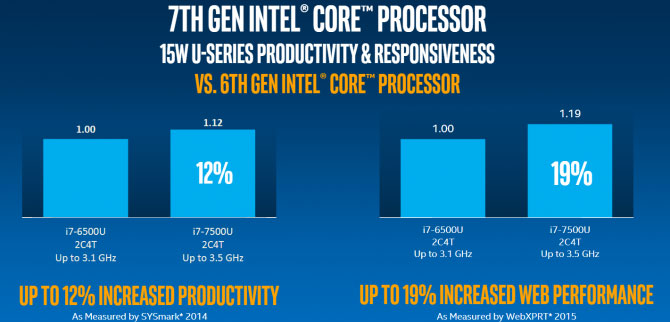
I don’t think that even a 19 percent advantage will spur buyers to change their not-so-good old Skylake to Kaby Lake. It is obvious that the increase in performance looks more significant when compared with processors of the 5th and 4th generations, which Intel is betting on updating processors to replace. The new Core i5-7200U is 1.7 times faster than its five-year-old Core i5-2467M sibling in SYSmark. On the 3DMark test new processor three times faster than a five-year-old processor.
Intel representatives said that the 7th generation CPUs will be able to play demanding games at medium settings at 720p with integrated graphics or at 4K with a compatible graphics amplifier.
These chips are for video
Intel has taken notice of all the 4K and 360 degree video we are consuming. In response, the chipmaker has introduced a new video engine for its 7-Gen core processors that aims to handle whatever content requirements you can throw at it.
The new chips support HEVC 10-bit color profile hardware decoding, which will allow you to play 4K and UltraHD video without any lag. Intel has also added VP9 decoding capability for 7th generation cores to improve performance when you watch 4K video while doing other tasks.
The 7th generation cores will also be able to perform video conversion operations much faster than other processors. For example, according to Intel, you can transcode 1 hour of 4K video in just 12 minutes.
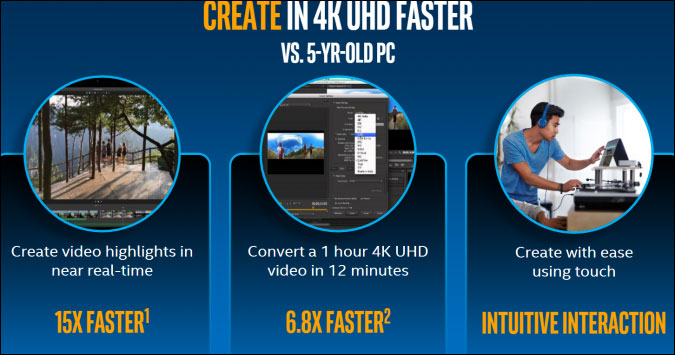
More energy efficiency
In terms of improving battery efficiency for laptops, Intel reported that a laptop with a 7th generation processor can last up to 7 hours when streaming 4K or 4K 360 degrees YouTube video. Compared to the 6th generation cores, the advantage in work will be an average of 4 hours in favor of the seventh generation. When it comes to 4K video streaming, Intel promises all-day performance, which is 9 and a half hours.
The 7th generation offers a number of other features
The 7th generation processors offer several other features designed to make your laptops run more efficiently. For example, Intel Turbo Boost Technology 2.0. This is a function that controls the performance of the processor and its power, such as automatic overclocking of the processor when clock frequency CPU exceeds performance ratings.
Hyper-Threading technology helps the processor complete tasks faster by providing two processing threads for each core.
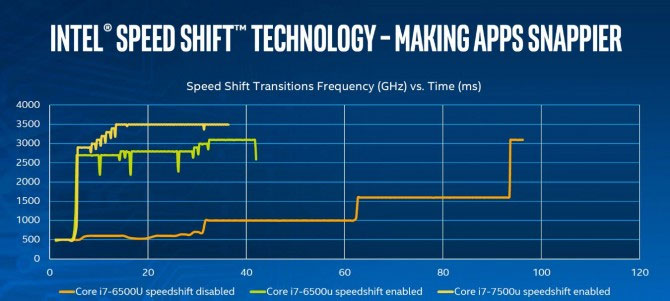
7th generation processors also include technology speed shift, which should make running applications faster. This technology allows the processor to be more responsive to application requests to increase or decrease frequency for the best performance, thereby optimizing performance and efficiency. This is especially effective when applications require very short bursts of activity, such as browsing the web or retouching photos with multiple brush strokes in a photo editor.
